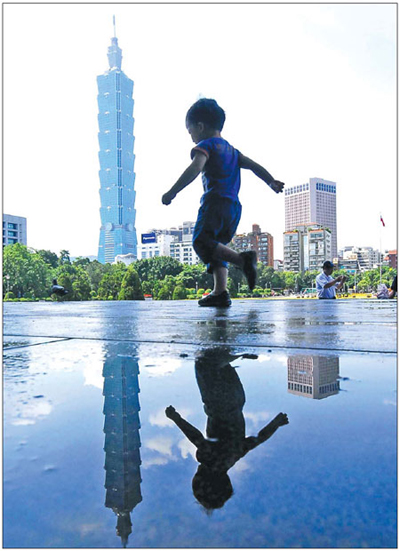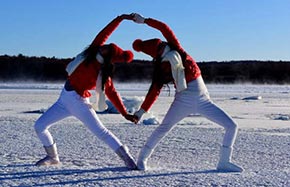Garden of earthly delights
 |
|
Clockwise from above:Wufenpu textile market is crammed with bargain-hunters but has a relaxed feel. Shin Yeh restaurant at Taipei 101. There's a temple on nearly every Taipei street corner. A plane flies overhead at Flora Expo. Cooking up a storm at Shihlin Night Market.[Photo/China Daily] |
 |
|
Taipei 101 rules the city's skyline.[Photo/China Daily] |

From the heights of Taipei 101 to the depths of sulfurous hot spring baths, the capital of Taiwan province offers a lot in 48 hours.
If all the time you have in Taipei is 48 hours, fear not, it will be a rapid succession of attractions wrapped up in a subtropical garden of delights. A weekend well spent. Its compact size and convenient transport options allows you to see and do more than you could in a week elsewhere.
The capital of Taiwan province is a concentrate of the mainland experience, slightly more traditional, with hints of Japanese, European and Aboriginal influences - and a style all its own.
If your hotel is centrally located none of the attractions suggested are more than an hour away and usually much less. They can easily be accessed on the Mass Rapid Transit (MRT) system, which is cheap, safe, clean and often elevates above the city to provide a golden sightseeing opportunity for the price of a ride.
Day 1
Take to the streets and seek out one of the ubiquitous mom-and-pop breakfast joints that sell a heady range of traditional and non-traditional snacks to start off your day.
My favorite is either steamed and pan-fried luobogao (turnip slices) and soy sauce, or a bacon sandwich with a beaker of iced tea, but there are plenty of other options.
Once you've filled up, head for Taipei 101 (Taipei City Hall MRT), which looks like a bamboo reed poking into the sky. You really can't miss it. Until recently it used to be the world's tallest building, and you are recommended to go straight to the top for a truly panoramic view of the city.
On a clear day, the city shimmers and merges into the mountain ranges that struggle to contain it. Aboriginal Ketagalan tribes controlled the Taipei Basin before the 18th century, when Chinese started settling in the area. The observation tower has maps of the city to reference, so it is a simple exercise to identify all the locations you plan to visit - a bit like looking at a satellite map.
When you've seen enough it's probably time for tea or coffee and a quick ride back down on the supercharged elevators, the world's fastest.
In the mall there are plenty of choices for light refreshment, before browsing the elegant lifestyle avenues, city squares and designer walks. High-end shopping is the order of the morning here, so come prepared with a credit card if you are in the mood to spend.
For a completely different shopping experience, head to the nearby textile market of Wufenpu (Houshanpi MRT). Named after five mainland settlers who bought "five parcels of land", it's a great place to polish your bargaining skills.
Originally, a wholesaler's market, this is where the smart young money does its shopping for clothes and accessories. It's crammed with bargain hunters, but has a laid-back atmosphere that is typically Taiwanese.
Lunchtime. As you might expect from a city with one of the highest population densities in the world, Taipei is packed with restaurants and good places to eat are on every street, although dining at a rickety table on plastic stools in a market is a must.
Savor beef noodle soup with cilantro, hot pot (known as shabu shabu ) with shacha sauce, dumplings at Din Tai Fung, dim sum at a number of hotels, Hakka or Kejia food, fish fare (Taiwan's an island) and cuisine based on dishes from all over China - but generally with a lighter touch, less salt and oil.
By now, you should have had enough of shopping and it's time to smell the roses, at the Flora Expo (Yuanshan MRT).
I'm not a keen gardener so I wasn't blooming with anticipation at the thought of going, but it turned out to be a highlight of my recent visit. It's the city's biggest ever event and expects to have pulled in up to 8 million people by the time it ends on April 25.
There's more than just horticulture, of course, with 14 pavilions, highlighting Chinese culture, the torch singer Teresa Teng, fashion demos, an eco park and visits to the Taipei Fine Arts Museum, among other draws.
Imagine walking around in fields of flowers surrounded by the buzz of a forward-looking 21st century city and you get the concept.
One stop away (Jiantan MRT) is Shihlin Night Market - one of the world's best in my humble opinion - and a great place to recharge on snacks and a juice drink, or simply enjoy the carnival spirit.
You will have to negotiate huge crowds, especially on the weekend, but try following your nose to Cicheng Temple, where you will find vendors selling smelly tofu, which you should try, if only to say you have. It's an unforgettable experience.
Your head should be swimming (after the tofu) and your feet aching by this point, so it's time to unwind in Beitou (Xin Beitou MRT).
One of the fortunate things about living in an active earthquake zone is sulfurous hot spring baths. Their health benefits were largely ignored before the Japanese invaded (1895-1945) and demonstrated they were pleasant to bathe in.
There are so many 24-hour hot spring hotels you can walk around and take your pick, and they range from five stars to bathhouse cheap.
It's late and you may be considering an early start next day, but for those of you revivified by the hot spring waters, head back downtown to find a lounge bar. It won't be difficult, the city is famous for them. My choices are Fifi's W Bar, Room 18, The Bed and possibly Champagne Bar.
Nightlife carries on till early morning most nights. If you fancy a late night snack before bed, try one of the all-night congee restaurants on Fuxing South Road.
Day 2
After the popular delights of the previous day and a street-side breakfast of youtiao (like doughnuts) and doujiang (sweet soybean milk), you will no doubt be champing at the bit for some highbrow culture and arguably there's no better place in the world for immersion in Chinese antiquities than the Taipei Palace Museum (Shilin MRT and bus R30).
It has a permanent collection of 677,687 Chinese artifacts and works of art, covering 8,000 years of history.
There's always something going on here as exhibitions come and go, but the real meat is in the permanent collection and it's certain you will be blown away by something, whether it's a painting by Zhang Daqian - China's Picasso - or a small piece of jadeite cabbage with insects crawling over it.
Looking around will take at least a morning and you are also recommended to get lunch or tea at one of the two cafes, while the elegant fourth floor Sanxitang Teahouse is well worth spending some downtime in.
After traipsing around the museum, get some wind in your sails with a bicycle ride along the riverside in Wanhua, one of the earliest settling points for seafaring traders in Taipei.
It's a 20-minute walk from Shuanglian MRT (Exit 2) to Dihua Street, but you won't be wasting your time as there are a number of stores selling traditional Chinese goods, such as dried foods, medicines and incense, in addition to the scenic value of Japanese and Qing Dynasty (1644-1911) era architecture, much of which has been preserved.
Nearby is Dadaocheng Port (marked by a full-scale model of a Qing boat), which is where you can hire a bicycle on the weekend and explore Danshui River. It's a green highway whether you head left or right, dotted with parks and pagodas and abundant bird life.
Dusk is the time to check in your bike and explore Ximending, where trends are set and tattoos inked. It's a great setting for connoisseurs of Japanese culture products and impromptu concerts by Mandopop demigods, especially on Saturday and Sunday afternoons.
If you have the time, dive into an MTV and choose from a large selection of films, moderately palatable food and drinks. Check out Monga, the 2010 film by Doze Niu that captures the feel of Wanhua district in the 1980s. Or, go to Red House Theater, built in 1908, for a drink at one of the lively and gay, literally, bars in the courtyard plaza.
The clock is ticking, the plane is booked for the next morning, and a longish MRT ride of 13 stops to Taipei Zoo awaits. It's worth it, of course, as there's a 4 km ride in a gondola up to Maokong, an ascent of 300 meters.
Observe Taipei twinkling below and then find a teashop draped in fairy lights that serves dinner, for an al fresco experience that is hard to beat.
Originally settled by mainland tea farmers from the south, there are Maokong plantation teas on offer as well as the better quality brews from Alishan and other "high mountain" resorts.
If it's after 10 pm, you will need to get a bus or taxi down from Maokong back to the MRT and downtown.
My final tip is the 24-hour bookshop on Dunhua South Road (Zhongxiao Dunhua MRT), where you can browse and read in good company to your heart's content before picking up a book for the plane home.
Yes, there's a lot you have missed, like one of the big-name temples such as Longshan or Confucius Temple, the fishing port of Danshui, Sun Yat-sen Memorial Park, Chiang Kai-shek Memorial Hall, a hike on Yangmingshan but you can always return.




















